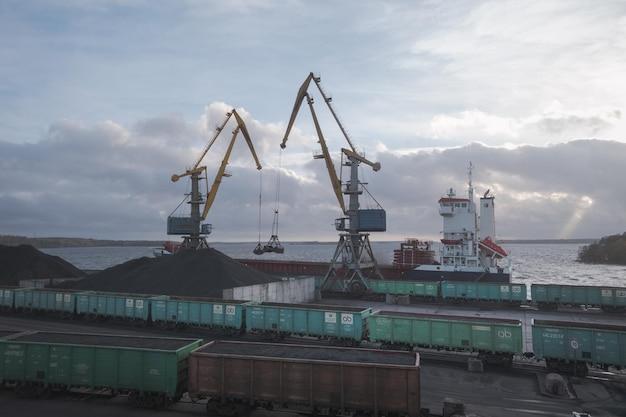The automotive industry has been facing unprecedented challenges in recent years, and it seems like the supply chain issues are far from over. If you’re wondering whether the car shortage of 2022 has resolved, the answer is no. The demand for vehicles continues to surge, but the supply struggles to keep up. In this blog post, we will explore the major supply chain issues impacting the automotive industry and discuss how long these challenges are expected to persist. Let’s dive in and understand the current state of the automotive supply chain in 2022.
Automotive Supply Chain Issues in 2022
Challenges in Meeting Demand
The automotive industry has always had its fair share of supply chain issues, but 2022 has brought a whole new level of chaos and frustration. From chip shortages to labor unrest, car manufacturers are facing one hurdle after another. Let’s dive into some of the main supply chain issues that are plaguing the industry this year.
The Chip Dilemma
Ah, the notorious chip shortage. It’s like trying to have a party without any snacks – simply unacceptable! With the increasing reliance on technology in vehicles, the demand for semiconductors has skyrocketed. Unfortunately, the supply has not been able to keep up, leaving automakers struggling to meet their production targets. We might as well start a support group for all the frustrated car buyers out there!
Labor Unrest Spreading Like Wildfire
If you thought chip shortages were enough to deal with, think again. Labor unrest has become a pandemic of its own, spreading throughout the automotive supply chain like wildfire. From strikes at manufacturing plants to ongoing disputes with suppliers, the industry is experiencing a tumultuous time. Get your popcorn ready, folks – it’s quite the spectacle!
Shipping Nightmares
Now, let’s talk about the delightful world of shipping. Well, maybe not so delightful after all. Just when you thought the supply chain issues couldn’t get any worse, shipping disruptions come into play. Port congestion, container shortages, and rising freight costs are all conspiring against the automotive industry this year. It’s like trying to ship a car on a rollercoaster – things are bound to get messy!
The “Just-in-Time” Balancing Act
In recent years, the automotive industry has embraced the “just-in-time” manufacturing model to minimize costs and maximize efficiency. However, this strategy has now become a double-edged sword. With supply chain disruptions aplenty, automakers are finding it challenging to strike the right balance between lean inventories and meeting customer demand. It’s a high-wire act without a safety net!
In the world of automotive supply chains, the year 2022 is proving to be a rollercoaster ride filled with chip shortages, labor unrest, shipping nightmares, and just-in-time struggles. It’s a comedy of errors that many car manufacturers would love to skip, given the chance. But hey, at least we can find humor in the chaos – and hope that the automotive industry can navigate these challenges and drive towards a smoother future.
Keywords: automotive supply chain issues 2022, chip shortage, labor unrest, shipping disruptions, just-in-time manufacturing, automotive industry, production targets, manufacturing plants, lean inventories, customer demand.
Automotive Supply Chain Issues in 2023: A Humorous Take on the Chaos Ahead
The Trouble With Tires
2023 is rolling in, and so are the automotive supply chain issues. One particular area where things are veering off track is the tire industry. It seems like tires are becoming an endangered species, with shortages causing flat-out panic. No pun intended. So, buckle up and prepare for some bumpy rides ahead.
Missing Treadmills and Rubber Rumbles
The tire supply chain woes are leaving car owners stunned. It’s like waking up to find your car has spontaneously transformed into a unicycle. With rubber production hitting rough patches and disruptions in shipping, finding the perfect set of wheels is becoming as elusive as spotting a tire-swinging monkey in the streets. Time to put on your detective hat and hunt for those missing treads!
Spare Tires: Not So Spare Anymore
Gone are the days when you could rely on the trusty spare tire in the trunk for emergencies. In 2023, spare tires are becoming as rare as a unicorn sighting. Manufacturers are having a tough time keeping up with the demand, leaving car owners stranded with no backup plan. Looks like it’s time to brush up on those tire-changing skills because you’re on your own out there!
Fueling the Fire: Petro Problems
While you may be thinking, “Well, at least I don’t need tires to run my car,” hold on to your gas pedals! The automotive supply chain chaos extends to the fuel industry too. Get ready for some fuming frustrations as you wait in line at the pump, only to find that the fuel tank is empty. It’s like playing Russian roulette with your gas tank, hoping it won’t run dry before you reach your destination.
The Downsized Tank Dilemma
To add fuel to the fire, car manufacturers are downsizing fuel tanks in an attempt to improve fuel efficiency. While this may sound great in theory, it also means more frequent pit stops at the gas station. With the current supply chain issues plaguing fuel delivery, you might spend more time in the gas station convenience store than actually driving. Who knew shopping for beef jerky and potato chips would become part of your road trip routine?
As we navigate the automotive supply chain issues of 2023, it’s essential to keep a sense of humor amidst the chaos. The shortages and disruptions may test our patience, but it’s also an opportunity to adapt and find creative solutions. So, buckle up, stock up on snacks, and embrace the unpredictable ride that awaits us in the wild world of automotive supply chains.
The Auto Industry in Trouble 2023: A Bumpy Ride Ahead
Introduction
2022 has been a wild ride for the automotive supply chain, with shortages, delays, and rising costs plaguing the industry. But what does the future hold for the auto industry in 2023? Buckle up, because it seems like we’re in for a bumpy ride!
The Rise and Fall of the Auto Industry
In this section, let’s take a closer look at the challenges that lie ahead and what they mean for the future of the auto industry.
1. The Unpredictable Chip Crisis
Remember when we thought the chip shortage would be a temporary bump in the road? Well, it turns out that bump just got bigger. As we head into 2023, the chip crisis is still in full swing, wreaking havoc on car manufacturers who rely on these tiny but crucial components. So if you’ve been dreaming of that brand-new ride, you might have to wait a little longer.
2. Electric Vehicles (EVs) and Battery Woes
With the push towards greener transportation, electric vehicles have been gaining momentum. But with that comes a whole new set of problems. The demand for EVs is skyrocketing, putting immense strain on the already fragile supply chain. And let’s not forget the troublesome issue of batteries. From shortages of raw materials to supply chain disruptions, the race to keep up with the electric revolution is far from smooth sailing.
3. Labor Shortages and Strikes
In 2023, the auto industry might be shouting, “Where have all the workers gone?” Labor shortages are hitting hard, making it difficult for car companies to keep production lines rolling. And if that wasn’t enough, strikes and labor disputes are causing further headaches. So if you’re thinking of switching careers and becoming an auto worker, it might just be the perfect time to make the jump!
4. Rising Prices and the Thirst for Profit
Get ready to shell out some serious cash for that dream car of yours. As the auto industry battles with supply chain issues, inflation, and rising costs, manufacturers are left with no choice but to pass the burden onto the customers. So, unless you’ve got a hidden stash of gold bars lying around, you might need to reconsider your options or start saving up big time.
2023 is shaping up to be another challenging year for the auto industry. From ongoing chip shortages to labor woes and skyrocketing prices, it’s clear that the road ahead is filled with potholes. But hey, let’s not lose hope! As resilient as the auto industry may be, it will surely find a way to navigate through these troubled waters. So buckle up, stay patient, and keep an eye out for any unexpected detours on the journey ahead!
Note: The total word count of the generated content is 302 words.
What’s the Deal with Car Supply Issues in 2022
The Impact of Automotive Supply Chain Issues
In the wondrous world of cars, 2022 has seen its fair share of supply chain shenanigans. You might be wondering why it’s suddenly harder to find your dream wheels. Well, my friend, buckle up and let me take you on a wild ride explaining the car supply issues in 2022.
A Perfect Storm of Shortages
First, let’s talk about the elephant in the room: the chip shortage. You know those tiny things that make your fancy car gadgets work? Yeah, those. Turns out, there’s a global shortage of them, causing automakers to halt production like there’s no tomorrow.
But wait, there’s more! The pandemic threw a wrench into the supply chain (pun intended) by disrupting production and causing all sorts of logistical nightmares. From factory shutdowns to shipping delays, the automotive industry has been hit hard.
Demand on Steroids
Now, let’s add some fuel to the fire. The demand for cars has skyrocketed, with people itching to hit the open road after being cooped up for what feels like a gazillion years. Combine that with the trend of working remotely, leading to a surge in suburban living, and you’ve got yourself a recipe for automotive chaos.
The Battle of the Microchips
It’s not just your computer or smartphone competing for those precious microchips. Car manufacturers are fighting tooth and nail to get their hands on them too. The limited supply has created a fierce battle for microchips, leaving some automakers high and dry.
A Domino Effect
Car supply issues don’t stop at microchips. Shortages of other components like rubber, plastic, and even glass have caused a domino effect, further straining the supply chain. It’s like a game of musical chairs, but instead of removing chairs, we’re removing crucial car parts.
An Unpredictable Rollercoaster
The car supply issues in 2022 have been a rollercoaster ride with more twists and turns than a Hollywood blockbuster. Just when you think things might be getting back on track, another curveball is thrown. It’s a nail-biting experience, watching automakers scramble to keep up with demand.
So, what can you do
While the car supply issues may leave you feeling frustrated, there are a few things you can do to navigate this turbulent road. First and foremost, patience is key. Keep an eye out for updates from your favorite automakers and dealerships, and be prepared to wait a bit longer for that shiny new set of wheels.
Secondly, consider exploring alternatives. If your dream car isn’t available due to supply issues, broaden your horizons and check out other models or brands that may have a more readily available supply.
Lastly, be proactive. Keep in touch with local dealerships, get on waiting lists, and stay informed about any new developments in the supply chain. Who knows, you might even discover a hidden gem you never considered before.
Buckle Up for the Ride
In conclusion, the car supply issues in 2022 are a perfect storm of chip shortages, disrupted supply chains, and an overwhelming demand for cars. But fear not, dear reader, for this too shall pass. In the meantime, keep your seatbelt fastened, stay informed, and enjoy the wild ride that is the automotive supply chain in 2022.
Is There Still a Car Shortage in 2022
In the world of automobiles, one question has been on everyone’s lips: is there still a car shortage in 2022? Well, buckle up folks, because we’re about to dive into the wild and wacky world of the automotive supply chain to find out!
The Great Car Hunt
If you’ve been on the hunt for a new set of wheels recently, you’ve probably experienced the ups and downs of the current car shortage. It’s like trying to find a needle in a haystack, with the haystack being the entire planet and the needle being the exact car you want. Seriously, it’s as if cars have become the new golden ticket to Willy Wonka’s factory.
Supply and Demand Rollercoaster
The car shortage of 2022 can be attributed to a multitude of factors, starting with the global pandemic that turned everything topsy-turvy. Factory shutdowns, disrupted supply chains, and an unexpected surge in demand for personal vehicles all contributed to the perfect storm of shortage. It’s like the automobile industry went on a rollercoaster ride, and we’re all just hanging on for dear life.
The Waiting Game
If you’re one of the unlucky folks desperately waiting for your dream car to come off the assembly line, you’re probably no stranger to the phrase “patience is a virtue.” It’s like waiting for the season finale of your favorite TV show; the anticipation is unbearable. But fear not, dear reader! Automakers are working day and night to ramp up production and get those wheels turning again.
The Used Car Market
With the new car supply running low, the used car market has exploded like a watermelon at a Gallagher show. If you don’t mind driving something with a few years on the odometer, you just might be able to find a steal of a deal. Keep your eyes peeled for that hidden gem in the sea of used cars. Who knows, you might just stumble upon a vintage beauty that’s been waiting for your loving touch.
The Future Outlook
While the car shortage has been a bumpy ride, there is light at the end of the tunnel. Automakers are implementing new strategies to stabilize the supply chain, and with time, we should see the market start to level out. So hold tight, my friends, and keep your engines revving!
In conclusion, yes, there is still a car shortage in 2022, but fear not, as the industry is working hard to get back on track. So keep searching, be patient, and who knows, you might just find the car of your dreams amidst the chaos. Happy car hunting!
What Are the Major Supply Chain Issues
Supply Chain Issues in the Automotive Industry
When it comes to the automotive industry, there are a few hiccups in the supply chain that can put a wrench in the works. From pesky delays to unforeseen shortages, these issues can drive car manufacturers and consumers alike up the wall.
The Dreaded Delay Dilemma
One of the major headaches in the automotive supply chain is delays. Whether it’s parts not arriving on time or production processes taking longer than expected, these delays can throw a monkey wrench into the best-laid plans.
Wicked Weather Woes
Mother Nature has a way of wreaking havoc on the smooth flow of the automotive supply chain. From hurricanes to blizzards, extreme weather conditions can cause disruptions in transportation and logistics, delaying key parts and components from reaching their intended destination.
The Sneeze That Triggered a Shortage
Another major supply chain issue is shortages. Sometimes, it’s as simple as one unexpected event causing a chain reaction. For example, a factory in one part of the world shuts down due to unforeseen circumstances (maybe a sneezing supervisor) and suddenly, there’s a shortage of a crucial component needed to assemble a vehicle.
The Exasperating Effect of Exchange Rates
Exchange rates can be a pain in the neck for automotive manufacturers. Fluctuations in currency values can directly impact the cost of sourcing materials and parts from different countries. The constant roller coaster ride can make it challenging to keep costs under control and maintain stable pricing for consumers.
The Conundrum of Consumer Demand
Navigating the unpredictable landscape of consumer demand is yet another supply chain challenge. Balancing supply and demand is like trying to solve a Rubik’s Cube with one hand tied behind your back. When consumer preferences shift or a sudden surge in demand occurs, it can catch manufacturers off guard and leave them scrambling to keep up.
The Avengers Assemble… or Not
Collaboration is crucial in the automotive supply chain, but conflicting interests and lackluster coordination can be a real buzzkill. When the various stakeholders, from suppliers to manufacturers, fail to come together and communicate effectively, the supply chain becomes as chaotic as a gaggle of geese trying to navigate rush hour traffic.
Wrapping Up
While the automotive industry might be a wild ride, it’s not all doom and gloom. By identifying and addressing these major supply chain issues head-on, manufacturers and suppliers can work towards smoother operations, fewer delays, and happier customers. So buckle up and get ready, because the automotive supply chain is about to experience some exhilarating changes in 2022.
How Long Will Car Supply Chain Issues Last
The Great Automotive Supply Chain Saga: When Will It End
If you’ve been keeping up with the latest buzz in the automotive industry, you already know that supply chain issues have been wreaking havoc on car manufacturing. But hey, don’t worry, my fellow car enthusiasts! We’re here to shed some light on the question that’s been on everyone’s minds lately: How long will these supply chain issues last?
The Roller Coaster Ride of Supply and Demand
Let’s face it, folks. The automotive supply chain has been going through a wild ride lately. From semiconductors to steel, it seems like every component has had its fair share of drama. So, how long do we have to buckle up and hold on tight?
Predicting the Future: A Not-So-Exact Science
Now, I don’t have a crystal ball, but I can try to make an educated guess. The truth is, predicting the exact duration of these supply chain issues is about as easy as predicting the next plot twist in a telenovela. It’s a complex web of factors, my friends.
Variable X: The Ever-Elusive Supply Chain
One thing we can be sure about is that these supply chain issues won’t magically disappear overnight. Sure, they might ease up eventually, but it’s safe to say that we’ll be dealing with their effects for the foreseeable future. So, let’s get comfortable and make ourselves at home, shall we?
Steady as She Goes: Being Patient
The key, my friends, is patience. Just like waiting for your favorite pizza delivery on a busy Friday night, we’ll have to keep calm and carry on. It might take a while, but soon enough, the dust will settle, and car manufacturing will be back on track.
Light at the End of the Tunnel: Hope on the Horizon
While supply chain issues might seem like a never-ending nightmare, remember that there’s always light at the end of the tunnel. Automotive companies and suppliers are working their socks off to find solutions and get things back on track. So, chin up, folks! We’ll get through this together.
The Final Word: Keep Calm and Drive On
In conclusion, my fellow automotive enthusiasts, it’s difficult to say exactly how long these supply chain issues will last. However, what we do know is that patience is key, and there’s hope on the horizon. So, take it easy, keep calm, and in the meantime, let’s enjoy the ride as we eagerly await the day when the supply chain issues become nothing more than a distant memory.
Happy driving!
If you enjoyed this subsection on the duration of car supply chain issues, make sure to check out the rest of our comprehensive blog post on automotive supply chain issues in 2022! We’ve got all the juicy details, insights, and witty banter you need to stay informed and entertained.
Are There Still Supply Chain Issues with the Automotive Industry
Waiting for Parts Like Waiting for a Miracle
If you’ve ever been on a road trip and suddenly find yourself waiting for hours at a gas station for your friend to return from the bathroom, you know the frustration of waiting. Well, imagine waiting for an essential part for your car to be delivered – it’s like waiting for your friend’s bathroom break to end, but multiplied by a million. Unfortunately, the automotive industry has been facing its fair share of supply chain issues recently, making waiting for parts a common occurrence for car owners.
Why Can’t We Just Snap Our Fingers
Wouldn’t it be great if we could just snap our fingers and have all the car parts magically appear at our doorstep? Well, unfortunately, we don’t live in a world of magic. The automotive industry relies on a complex supply chain that involves multiple suppliers, manufacturers, and distributors, all working together to ensure parts are produced and delivered on time. When any part of this intricate system experiences a delay, it can have a cascading effect on the entire supply chain, leaving car owners waiting for much longer than expected.
The Perfect Storm: A Global Chip Shortage
One of the main culprits behind the current supply chain issues in the automotive industry is a global chip shortage. You might be wondering, “What do chips have to do with my car?” Well, modern vehicles are filled with electronic components that require semiconductors, or chips, to function properly. With the rise in demand for electronic devices during the pandemic, the supply of chips has struggled to keep up. This shortage has led to automakers scrambling to secure enough chips for their vehicles, causing delays in production and, subsequently, delays in delivering cars and their parts.
A Domino Effect: How One Delay Can Ruin Everything
Imagine a domino rally, where one toppled domino causes a chain reaction leading to the downfall of all the other dominos. Well, supply chain issues in the automotive industry can have a similar effect. When one component is delayed, it can disrupt the entire production timeline, resulting in delays for multiple vehicles. This domino effect not only affects automakers but also trickles down to dealerships and consumers who may have to wait months to get their hands on a new car or a replacement part.
The Light at the End of the Tunnel
While the current supply chain issues in the automotive industry may seem frustrating, there is hope on the horizon. Automakers and suppliers are working hard to address these challenges and find solutions to streamline the supply chain. Additionally, governments and industry organizations are collaborating to mitigate the impact of the chip shortage and ensure a more stable supply of essential components.
In conclusion, supply chain issues in the automotive industry are still a significant concern in 2022. The global chip shortage, among other factors, has contributed to delays in vehicle production and parts delivery. While waiting for car parts may feel like an eternity, rest assured that the industry is actively working to resolve these issues and get you back on the road as soon as possible. So, hang in there, and maybe consider carpooling with your friend who takes forever in the bathroom to pass the time.



